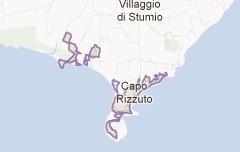 The sea area of Capo Rizzuto is the most extensive of Italy, with a surface of 15 thousand hectares of sea. Eight promontories limit the protected area, the first of which, Capocolonna, represents a real archeological deposit, evidence of the glorious splendours of the Magna Graecia. Here rises the only remaining Doric column of the famous temple dedicated to the goddess Hera Lacinia.
The sea area of Capo Rizzuto is the most extensive of Italy, with a surface of 15 thousand hectares of sea. Eight promontories limit the protected area, the first of which, Capocolonna, represents a real archeological deposit, evidence of the glorious splendours of the Magna Graecia. Here rises the only remaining Doric column of the famous temple dedicated to the goddess Hera Lacinia.
Coasting the protected area, one reaches 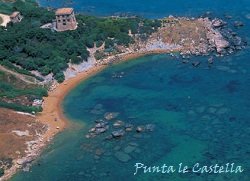 Punta Le Castella, last bulwark of the reserve, with the byzantine fortress on a small island where Ugurk-ali was born, commander of the imperial fleet of Constantinople.
Punta Le Castella, last bulwark of the reserve, with the byzantine fortress on a small island where Ugurk-ali was born, commander of the imperial fleet of Constantinople.
The territory of the province comprises even wide areas of geological as well as of naturalistic interest, such as the Montagnella Park with the Giglietto Valley or the peak of the Pizzuta Mountain – and, of course, the National Park of the Sila: its forests and woods represent an inestimable heritage for the community and for the entire nation.
The Palumbo village is one of the richest places in arts and folklore of the region. Situated at 20 km from Cotronei, Palumbo offers marvellous landscapes, from the Ampollino Lake to the endless forest. The Principe village, situated at 1479 metres, is immersed in woods of black pine and beech, enriched by a fabulous underwood.
According to Ovid’s legend, the capital owes its name to Hercules: the half god, returning from one of his mythological labours, wanted to honour his friend Crotone, accidentally injured to death by the hero himself; to make up for the big mistake, he built a memorial city. According to history, this is the city of the Greek school founded by Pythagoras and native land of the olympic athlete Milo.
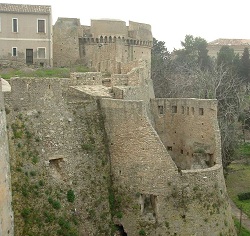 Among the most renowned sites, the Castle of Charles V is situated in the ancient part of the city, and so is the Cathedral, which hosts important and precious handiworks. Along the fortified walls of the castle lays the historic city centre with its nobility palaces, which can be seen in the ancient city. The National Archaeological Museum hosts unique pieces, first of all Hera’s treasury.
Among the most renowned sites, the Castle of Charles V is situated in the ancient part of the city, and so is the Cathedral, which hosts important and precious handiworks. Along the fortified walls of the castle lays the historic city centre with its nobility palaces, which can be seen in the ancient city. The National Archaeological Museum hosts unique pieces, first of all Hera’s treasury.
Just few kilometres away from the city, the archaeological area of Capo Colonna, where the ancient temple of Hera Lacinia once rose.
Cirò, renowned for the homonymous wine, is situated on a hill dominating Punta Alice, around the remains of the Carafa’s Feudal Castle. The ancient village is well preserved and comprises many genteel dwellings, tangled streets, flights of steps and religious buildings. The most ancient part of the village begins at Porta di Mavilia. In this area historic residences like the Capoano Palace, the Vergi palace, the palaces Pignataro, Astorini-Susanna, Liotti and Adorisio can be admired.
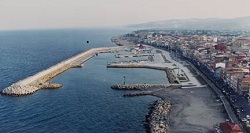 Cirò Marina was detached from the municipality of Cirò in 1952. Relevant its important archaeological and cultural centres, like the ruins of Apollo’s temple in Doric style discovered in 1921 in Punta Alice. The centre of the town is surrounded by orange grooves, vineyards and olive grooves. Since 2004 it has been awarded the blue flag for the quality of the sea and the services.
Cirò Marina was detached from the municipality of Cirò in 1952. Relevant its important archaeological and cultural centres, like the ruins of Apollo’s temple in Doric style discovered in 1921 in Punta Alice. The centre of the town is surrounded by orange grooves, vineyards and olive grooves. Since 2004 it has been awarded the blue flag for the quality of the sea and the services.
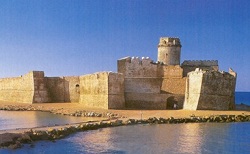 Isola di Capo Rizzuto has very ancient origins. Its name derives from the term asylos, which indicates a shelter. Le Castella is a very famous resort characterized by the beauty of the sea and of its Aragonese Castle, which seems to rise out of the waters, linked to the land by a small strip of land. Not to be missed, the Cathedral, reminding that Isola has been an episcopal seat until 1818. Furthermore, the Aquarium, which is also an Educational Centre for the Sea Environment, dedicated especially to younger visitors. And finally the Old Tower and the New Tower, parts of the coastal defensive system.
Isola di Capo Rizzuto has very ancient origins. Its name derives from the term asylos, which indicates a shelter. Le Castella is a very famous resort characterized by the beauty of the sea and of its Aragonese Castle, which seems to rise out of the waters, linked to the land by a small strip of land. Not to be missed, the Cathedral, reminding that Isola has been an episcopal seat until 1818. Furthermore, the Aquarium, which is also an Educational Centre for the Sea Environment, dedicated especially to younger visitors. And finally the Old Tower and the New Tower, parts of the coastal defensive system.
 San Severina is one of the most suggestive centres of the region: It is situated on a rocky cliff at 326 metres above the sea level, in the centre of the valley of the Neto river. Due to its peculiar location, it is called the "stone ship”. San Severina’s Castle, with its imposing four towers, can be seen from every corner of the valley. The cathedral dates back to the 13th century and still bears the traces left by the historical changes brought in during the centuries. The Church of Santa Filomena, also known as "Pozzolino", is developed on two levels and the lower part is dedicated to the Madonna del Pozzo
San Severina is one of the most suggestive centres of the region: It is situated on a rocky cliff at 326 metres above the sea level, in the centre of the valley of the Neto river. Due to its peculiar location, it is called the "stone ship”. San Severina’s Castle, with its imposing four towers, can be seen from every corner of the valley. The cathedral dates back to the 13th century and still bears the traces left by the historical changes brought in during the centuries. The Church of Santa Filomena, also known as "Pozzolino", is developed on two levels and the lower part is dedicated to the Madonna del Pozzo
Artistic Itineraries drawn to discover the archaeological sites alternate with the many available excursions in the natural parks and on the mountains. On the Ampollino Lake it is possible to enjoy very nice adventures on a canoe or pedalo. And the marquisate can be explored via bicycle pathways along naturalistic and historical-cultural itineraries.
Among the most visited, the territory of the former Cutro-Crotone-Papanice railway, with the undamaged galleries and a fauna rich of herons and coots in springtime. T
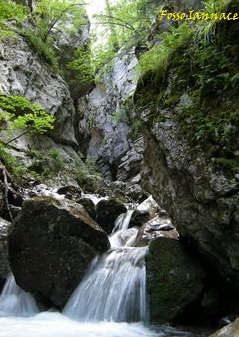 The Macchia dell'Arpa itinerary forms a circle and develops in the beech vegetation area entering zones 1 and 2 of the National Park of the Sila. Going through the woods, it is possible to admire the uncontaminated sources and the unique granite rocks of Fosso Iannace. Finally, many cyclists venture into the elliptic route of the Gariglione, an oasis of rare beauty in the heart of the National Park of the Sila.
The Macchia dell'Arpa itinerary forms a circle and develops in the beech vegetation area entering zones 1 and 2 of the National Park of the Sila. Going through the woods, it is possible to admire the uncontaminated sources and the unique granite rocks of Fosso Iannace. Finally, many cyclists venture into the elliptic route of the Gariglione, an oasis of rare beauty in the heart of the National Park of the Sila.
The excursions through the National Park of the Sila represent a unique chance for photography, bird-watching and bio-watching buffs. Furthermore, the peak of the S. Barbara mountain is used as an Astronomic Observatory.
River Trekking is a way to live in touch with wilderness and uncontaminated environments. The excursions follow the watercourse, usually stepping right in the water, moving upstream. In some cases, as for the low gorges of Tacina, Migliarite and Senapite, the excursions are very difficult, suitable for skilled and trained hikers, even if they result to be very pleasing. In others, as for the sources of the Tacina or the Vergari path, they are accessible even by the less expert. Some of the paths lead directly into the water, partially even forcing to swim.
There are many SSSIs (Site of Specific Scientific Interest) to be discovered: in Zinga, the Hypogeic Geopark Alto Crotonese, the CEA Villa Daino (Centre for Environmental Experience).
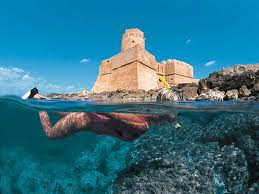 Sea lovers can venture into underwater routes to discover the fauna and the flora of the protected area of Isola di Capo Rizzuto and the unique seabeds along the coast which extends from Cirò Marina to Capo Piccolo.
Sea lovers can venture into underwater routes to discover the fauna and the flora of the protected area of Isola di Capo Rizzuto and the unique seabeds along the coast which extends from Cirò Marina to Capo Piccolo.
The most famous product of the province is for sure the wine of Cirò, DOC (registered designation of origin) of excellence.
Beyond it, the bread of Cutro is to be mentioned, also exported to many regions in the North of the Country, made with durum wheat. Among the typical products: the pecorino cotronese, made with sheep milk produced locally; the suppressata, a typical local salami; and the sardella, also called caviar of the South, or of the poor, produced by processing fish with hot pepper and wild spices. “Pipi and patati”, on the other hand, is a typical summer dish made with sweet peppers and potatoes sautéed with garlic and olive oil.
Point of Interest in the provinces of : Cosenza | Crotone | Catanzaro | Vibo Valentia | Reggio di Calabria |


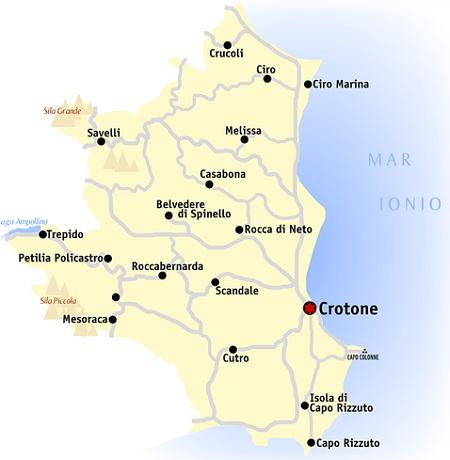
 The sea area of Capo Rizzuto is the most extensive of Italy, with a surface of 15 thousand hectares of sea. Eight promontories limit the protected area, the first of which, Capocolonna, represents a real archeological deposit, evidence of the glorious splendours of the Magna Graecia. Here rises the only remaining Doric column of the famous temple dedicated to the goddess Hera Lacinia.
The sea area of Capo Rizzuto is the most extensive of Italy, with a surface of 15 thousand hectares of sea. Eight promontories limit the protected area, the first of which, Capocolonna, represents a real archeological deposit, evidence of the glorious splendours of the Magna Graecia. Here rises the only remaining Doric column of the famous temple dedicated to the goddess Hera Lacinia. Punta Le Castella, last bulwark of the reserve, with the byzantine fortress on a small island where Ugurk-ali was born, commander of the imperial fleet of Constantinople.
Punta Le Castella, last bulwark of the reserve, with the byzantine fortress on a small island where Ugurk-ali was born, commander of the imperial fleet of Constantinople. Among the most renowned sites, the Castle of Charles V is situated in the ancient part of the city, and so is the Cathedral, which hosts important and precious handiworks. Along the fortified walls of the castle lays the historic city centre with its nobility palaces, which can be seen in the ancient city. The National Archaeological Museum hosts unique pieces, first of all Hera’s treasury.
Among the most renowned sites, the Castle of Charles V is situated in the ancient part of the city, and so is the Cathedral, which hosts important and precious handiworks. Along the fortified walls of the castle lays the historic city centre with its nobility palaces, which can be seen in the ancient city. The National Archaeological Museum hosts unique pieces, first of all Hera’s treasury. Cirò Marina was detached from the municipality of Cirò in 1952. Relevant its important archaeological and cultural centres, like the ruins of Apollo’s temple in Doric style discovered in 1921 in Punta Alice. The centre of the town is surrounded by orange grooves, vineyards and olive grooves. Since 2004 it has been awarded the blue flag for the quality of the sea and the services.
Cirò Marina was detached from the municipality of Cirò in 1952. Relevant its important archaeological and cultural centres, like the ruins of Apollo’s temple in Doric style discovered in 1921 in Punta Alice. The centre of the town is surrounded by orange grooves, vineyards and olive grooves. Since 2004 it has been awarded the blue flag for the quality of the sea and the services. Isola di Capo Rizzuto has very ancient origins. Its name derives from the term asylos, which indicates a shelter. Le Castella is a very famous resort characterized by the beauty of the sea and of its Aragonese Castle, which seems to rise out of the waters, linked to the land by a small strip of land. Not to be missed, the Cathedral, reminding that Isola has been an episcopal seat until 1818. Furthermore, the Aquarium, which is also an Educational Centre for the Sea Environment, dedicated especially to younger visitors. And finally the Old Tower and the New Tower, parts of the coastal defensive system.
Isola di Capo Rizzuto has very ancient origins. Its name derives from the term asylos, which indicates a shelter. Le Castella is a very famous resort characterized by the beauty of the sea and of its Aragonese Castle, which seems to rise out of the waters, linked to the land by a small strip of land. Not to be missed, the Cathedral, reminding that Isola has been an episcopal seat until 1818. Furthermore, the Aquarium, which is also an Educational Centre for the Sea Environment, dedicated especially to younger visitors. And finally the Old Tower and the New Tower, parts of the coastal defensive system. San Severina is one of the most suggestive centres of the region: It is situated on a rocky cliff at 326 metres above the sea level, in the centre of the valley of the Neto river. Due to its peculiar location, it is called the "stone ship”. San Severina’s Castle, with its imposing four towers, can be seen from every corner of the valley. The cathedral dates back to the 13th century and still bears the traces left by the historical changes brought in during the centuries. The Church of Santa Filomena, also known as "Pozzolino", is developed on two levels and the lower part is dedicated to the Madonna del Pozzo
San Severina is one of the most suggestive centres of the region: It is situated on a rocky cliff at 326 metres above the sea level, in the centre of the valley of the Neto river. Due to its peculiar location, it is called the "stone ship”. San Severina’s Castle, with its imposing four towers, can be seen from every corner of the valley. The cathedral dates back to the 13th century and still bears the traces left by the historical changes brought in during the centuries. The Church of Santa Filomena, also known as "Pozzolino", is developed on two levels and the lower part is dedicated to the Madonna del Pozzo The Macchia dell'Arpa itinerary forms a circle and develops in the beech vegetation area entering zones 1 and 2 of the National Park of the Sila. Going through the woods, it is possible to admire the uncontaminated sources and the unique granite rocks of Fosso Iannace. Finally, many cyclists venture into the elliptic route of the Gariglione, an oasis of rare beauty in the heart of the National Park of the Sila.
The Macchia dell'Arpa itinerary forms a circle and develops in the beech vegetation area entering zones 1 and 2 of the National Park of the Sila. Going through the woods, it is possible to admire the uncontaminated sources and the unique granite rocks of Fosso Iannace. Finally, many cyclists venture into the elliptic route of the Gariglione, an oasis of rare beauty in the heart of the National Park of the Sila. Sea lovers can venture into underwater routes to discover the fauna and the flora of the protected area of Isola di Capo Rizzuto and the unique seabeds along the coast which extends from Cirò Marina to Capo Piccolo.
Sea lovers can venture into underwater routes to discover the fauna and the flora of the protected area of Isola di Capo Rizzuto and the unique seabeds along the coast which extends from Cirò Marina to Capo Piccolo.
